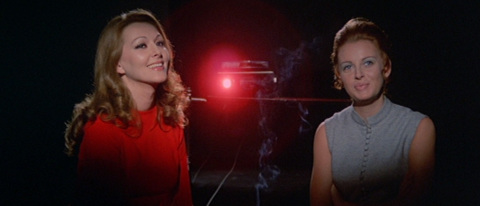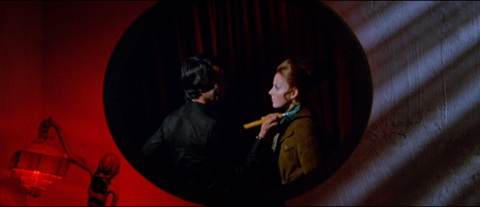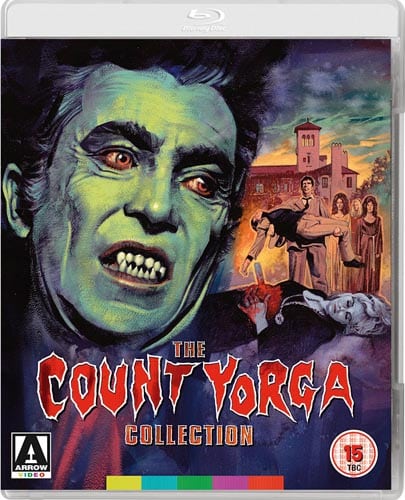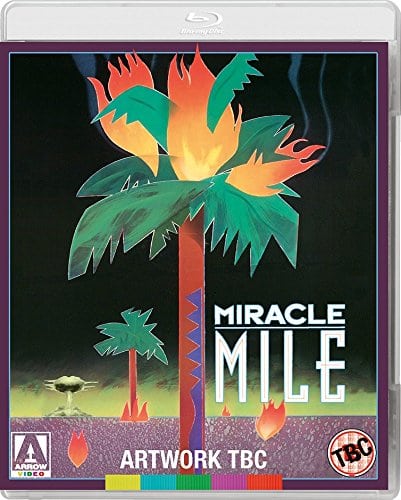The Forbidden Photos of a Lady Above Suspicion (1970)
Directed by: Luciano Ercoli
Written by: Ernesto Gastaldi
Starring: Dagmar Lassander, Nieves Navarro, Pier Paolo Capponi, Simón Andreu
AKA LE FOTO PROIBITE DI UNA SIGNORA PER
Italy/Spain
AVAILABLE ON BLU-RAY: NOW, from ARROW VIDEO
RUNNING TIME: 93 mins
REVIEWED BY: Dr Lenera, Official HCF Critic
Minou is newly married to Peter, a businessman in debt as he works to bring a new product to market, but Peter is rarely at home. One night on the beach, a stranger cuts open Minou’s clothes and tells her that Peter has murdered a business associate, then telephones her to play her a tape recording of Peter discussing the murder. He tells Minou that he’ll go public with this evidence if she does not come to his house and sleep with him, then compounds the blackmail with photos taken of their tryst. And what does Dominique, Minou’s best friend who introduced the pair, know about all this?….
It was, of course, Dario Argento’s The Bird With The Crystal Plumage that began the mini giallo craze in the early ’70s, Italian cinema goers for a while barely able to move for black gloved assassins and twisty, sleazy murder mysteries. However, every fan probably knows that the form had already been around for some time, and that it was in fact virtually invented by Mario Bava with The Girl Who Knew Too Much and Blood And Black Lace in 1963/64, after which quite a few giallos were made which weren’t the bloody, murder filled slices of mayhem these films later became. Instead, one can class them more as erotic thrillers. One wonders if there would have been more efforts like The Forbidden Photos Of A Lady Under Suspicion if Argento hadn’t made his film soon after its release, causing so many others to cash-in on its success. I’ve been interested in seeing the first of the three collaborations between director Luciano Ercoli and screenwriter Ernesto Gastaldi ever since I reviewed the other two, also out on Arrow Video, some time ago. Death Walks At Midnight and Death Walks In High Heels proved to be fairly entertaining giallos without too much Argento mimicking. The Forbidden Photos Of A Lady Under Suspicion, which is nothing like the much praised and award winning Investigation Of A Citizen Above Suspicion but probably intended its title to sound similar, is pretty much the same quality of the other two. I found it rather predictable, which is a problem if you’re as bad a movie detective as I am, and there aren’t really enough memorable sequences to keep things tense, while its sexual politics don’t bare thinking about if you’re a politically correct sort. However, set in a very chic, decadent world where it seems perfectly normal for someone to invite their friend over for tea and show them their porn photos [of themselves], there’s no doubt that the film casts a kind of spell with its set design, cinematography and music especially important in contributing to its effect. And it has one of Italian cult cinemaicon Dagmar Lassander’s most notable roles, even if she doesn’t quite seem up to it.
As often with these films, there’s little background information easily available, so let’s get into the film proper. A pan down some ancient ornaments on a wall reveals our heroine taking a bath. Her voice over informs us that she’s going to give up cigarettes, smoking and pills, but she goes on to spend much of the film consuming all three of those things. Then she says how she’ll wind her husband up by saying she’s having dinner with someone else, or that they can’t have sex for a while, or that they’re getting a divorce. She’s bored because hubby is constantly away you see [as it’s 1970 there’s no phone to fiddle of course and not even a TV from the looks of it], and perhaps the most unbelievable aspect of the whole film from this male perspective is that a man would seem not to want to spend as much time with the stunningly beautiful Lassander as possible. Minou goes for a walk on the beach, and is accosted in a really well handled scene making fabulous use of shadow as she tries to hide from her attacker. “Soon you will be begging me to take you” he says after his claim about her husband being a murderer. Sadly this is virtually what happens when he blackmails her. Their lovemaking is cut short, but then flashed back to later on, inter-cut with the red statue of a devil bathed in red light [subtle, this film]. Though obviously limited by censorship of the time so the emphasis is mostly on writhing feet, we get the idea that their encounter was perverse and degrading, but probably enjoyed by Minou more then she lets on.
Of course, this is typical sexist male fantasy stuff, something that you could also say with the character of Dominique, Minou’s friend who is characterised purely as being promiscuous and a sexual adventuress [“I wish something like this had happened to me” she says when Minou tells her of her ordeal], though others may seen the character as refreshing, and anyway this is a giallo [never the most ‘progressive’ genre] from a time when many filmmakers, especially filmmakers making films like this, didn’t give a damn about being PC. To be honest, anybody offended should probably give up on giallos right now. More bothering to me was Minou’s actions. If she thinks Peter is innocent, why does she let the blackmailer humiliate her? If she thinks Peter is guilty, why is she protecting him? And surely even back then anybody could have put together an incriminating tape recording which doesn’t really prove anything? This really isn’t one of Gastaldi’s better giallo scripts. Anyway, the man then threatens to release photos of them together if she doesn’t come back to him, and proceeds to appear to her at regular intervals. Dominique is revealed to be sleeping with Peter, and then the blackmailer turns up in one of Dominique’s many ‘personal’ photographs. As for Peter, he was apparently supposed to pay a loan to the man whose corpse turns up just like the blackmailer said. There’s some muddled stuff about the nature of the man’s death that links it to things that the company which Peter works for, though this disappears from the script after a while.
There’s a fairly good version of the familiar scene, possibly first introduced in the Hitchcock version of The Thirty-Nine Steps, where somebody leads the police to where dodgy going-ons have taken place but the room or house is now totally different with no signs whatsoever of what the person described to the police. The cops and possibly even Peter think that Minou could be insane, but the viewer is never really led to think that this could be a possibility, which is a shame as it would have added some needed edge to the proceedings. Proper suspense only really rears its head in the final act with some very creepy and tense moments when the blackmailer might be in Minou’s house. These are so well handled that you wish more of the film had been like this. Going by the standards of the genre, the story doesn’t really have enough surprises and Ercoli tends to overuse certain devices like voice over [a soup eating scene is unintentionally funny in this respect] in an effort to maintain interest. And sadly the delectable Lassander isn’t quite up to the role, tending to rely on the same rather vacant expression throughout until towards the end where she seems to make more of an effort, though Simon Andreu is suitably scary without becoming histrionic as the blackmailer and would go on to play similar parts including in Ercoli’s other two giallos. Susan Scott [real name Nieves Navarro, and the wife of the director] also out acts Lassander as Dominique despite being given a pretty thin character to play. She gives the part a slight comic touch in a film that sometimes seems on the edge of parody anyway despite ostensibly being mostly serious, and is given some amusing business to do at the end, which concludes in an extremely upbeat fashion that some may find out of place but to me has a great sense of liberation about it.
Visually and aurally the film, which was shot in Barcelona but could be almost anywhere by the coast in the southern part of Europe, really scores. A great deal of effort has been made in the areas of interior and set design and you can virtually view the film as a slightly exaggerated time capsule of the era that taste forgot – or broke new boundaries [you decide]. The odd mixture of colours and objects in the blackmailer’s apartment [love those plaster hands and masks on the walls] are utilised especially well and give the scenes set there an almost surreal quality. Cinematographer Alejandro Ulloa is one of the film’s heroes, having black fall across objects and people’s faces in a manner akin to the great film noirs, giving us nice single shots like a red car driving away from a place where everything else, not just the other cars, has a blue-ish tint, and letting us plunge into a river and come out of a cup of tea! Even the typically unconvincing ‘day for night’ scenes are at least nice to look at. And you wouldn’t think that this was Ercoli’s first film considering how assured yet stylish his handling of the widescreen format is. Meanwhile the ears are treated to an especially cool Ennio Morricone score. His familiar female wordless vocalist Edda d’Orso gets the chance to actually sing some [hard to decipher] proper lyrics in the catchy bossa nova-style main theme. The other major theme tracks is more laid back but still with a strong rhythmic emphasis, and you also get some almost nightmarish atonal suspense stuff and some insanely groovy Morricone disco. Those familiar with much of this great composer’s music will notice early versions of certain devices that would turn up in later giallo scores. I consider much of his giallo work to be among his best, partly because it seems that Morricone is having so much fun writing the music, yet the man himself sadly doesn’t seem to think so seeing as it never seems to be played at his concerts.
The Forbidden Photos Of A Lady Under Suspicion doesn’t quite work in the way that it should, and it’s certainly not the film to begin with if you’re new to the giallo genre, but it’s still rather interesting anyway. For maximum enjoyment, pour yourself a glass or three of your favourite alcoholic beverage, relax, don’t pay too much attention to what’s exactly going on, and just bathe in the visual and aural stimulus. And talking of booze, this may have been made before the deal was done to put J&B Whiskey in nearly every giallo, because instead we get a zoom into some Carlsberg beer glasses!
Rating: 









The bright colours pop out, the blacks have no crush, the detail is terrific and the grain is evenly managed in this absolutely stunning restoration done by Arrow themselves. I really can’t fault it. Moving on to the audio, this is one giallo where the Italian soundtrack is definitely the one to go for, because every cast member seems to be speaking Italian or Spanish, and the English dub sounds especially tinny if not too bad where voices are concerned.
Arrow give us four special features which are all different, that compliment each other, and which repeat very little. I’ve really enjoyed Kat Ellinger’s pieces in other Arrow releases, so I was looking forward to her first audio commentary, and she generally doesn’t disappoint despite not being very scene specific and one gaff where she mentions Bruno Nicolai instead of Ennio Morricone. She goes deep into the film’s themes and its placing in its genre, and praises it for being intuitive to female desire, which is probably quite unusual but it’s wonderful to have a female be a fan of a genre that’s often considered to be misogynist. She also interprets the ending much the same as I do! Occasionally the usual biographies slow things down but this is a strong debut commentary and certainly left me with more understanding and even appreciation of a film I found very flawed despite its pleasures.
Private Pictures has Ercoli, Navarro and Gastaldi discuss how they got into the movie business before going onto The Forbidden Photos Of A Lady Under Suspicion. Gastaldi is new footage, the other two archival, though the featurette is put together seamlessly. Ercoli tells of how he was scared to ask Morricone to score the film then had Morricone come to him to ask if he could score it, Navarro really seems to love the film, and Gastaldi uses yet another opportunity to put Dario Argento down. The very animated Gastaldi also mentions some ways in which Ercoli altered his script. The movie’s plot and its themes aren’t really covered, but most other things are. It was apparently a major hit in Italy.
And then we get to my favourite of the special features. As a movie soundtrack lover and fan of Morricone which you no doubt deduced from my review of the film, The Forbidden Soundtrack of the Big Three was pure joy. ‘Lovely Jon’ [no, me neither though I hope he pops up in more Arrow discs] talks with great enthusiasm but also with great knowledge about how much some of Morricone’s collaborating musicians contributed to many of his scores, especially Alessandro Alessandroni and Bruno Nicolai [apparently those two plus Morricone would often set up beds and sleep in the studio because of the work load] who have been rather overlooked, then goes on to analyse the score’s three main pieces before lamenting how Morricone’s output for these films was almost ignored for years. Jon actually knew and played music with Alessandroni and tells a great story about him.
Finally we have The Forbidden Lady, an interview with Lassander from 2016 who begins by complaining that she can’t smoke. She says how she doesn’t remember much and how she doesn’t even like thriller or horror films very much, but she’s still a great sport, very bubbly and a teller of some fine stories like when she arrived in Dublin to shoot a film with a suitcase which had blood leaking out of it. Being as I’ve been doing a series of Lucio Fulci reviews I was also very interested to hear her recollections of Fulci with whom she worked twice, though the picture she paints of him will be a very familiar one to many. Apparently the well known tale of the wall supposedly almost killing her while filming The Black Cat wasn’t quite true – she was actually nearly burnt to death. This interview finishes with a few questions from audience members. The whole thing is a little blurry but a worthy addition to the extras nonetheless.
While the film wasn’t totally successful to my eyes, I can’t deny its coolness and can see why some giallo fans love it, while Arrow’s presentation of it is absolutely first class in terms of the film itself and the consistently interesting and well chosen special features. Therefore Arrow’s release of The Forbidden Photos Of A Lady Under Suspicion comes Recommended by the Doc.
SPECIAL EDITION CONTENTS
*Brand new 2K restoration from the original camera negative by Arrow Films
*High Definition Blu-ray (1080p) presentation
*Original lossless mono Italian and English soundtracks
*English subtitles for the Italian soundtrack
*Optional English subtitles for the deaf and hard of hearing for the English soundtrack
*New audio commentary by Kat Ellinger, author and editor-in-chief of Diabolique Magazine
*Private Pictures, a newly-edited documentary featuring archival interviews with actress Nieves Navarro and director Luciano Ercoli, and new interview material with writer Ernesto Gastaldi [44 mins]
*The Forbidden Soundtrack of the Big Three, a new appreciation of the music of Forbidden Photos and 70s Italian cult cinema by musician and soundtrack collector Lovely Jon [47 mins]
*The Forbidden Lady , an interview followed by a Q&A with actress Dagmar Lassander at the 2016 Festival of Fantastic Films [44 mins]
*Original Italian and English theatrical trailers
*Image gallery
*Reversible sleeve featuring original and newly commissioned artwork by Twins of Evil
FIRST PRESSING ONLY: Illustrated collector’s booklet featuring new writing on the film by author and critic Michael Mackenzie








Thanks so much for taking the time to discuss Vamporama Films’ documentary extra The Forbidden Lady as well as the main feature, and for making clear I conducted an actual interview rather than (as perversely listed on the original press press release and subsequent packaging) merely hosted an audience Q&A. Regarding the “blurry” image quality, that is a fair comment but unfortunately an unavoidable situation: the main camera (controlled by the festival itself) was not optimal, whilst the material shot from the side was only ever intended as a personal record, since I had originally planned to sell this as a print interview. However, Arrow Films heard a video version existed and got in touch to commission a documentary from myself and editor Chrissie Harper utilising both sets of footage. I am, of course, pleased to hear you felt the effort paid off and that despite its visual limitations, The Forbidden Lady makes “a worthy addition” to this memorable Blu-ray release.
Thank you for your kind comment Steve which was also interesting to read. These days I do usually try to go through the special features on discs I review and write a few words, as I feel it’s of interest, especially to those who may have seen the film many times before.